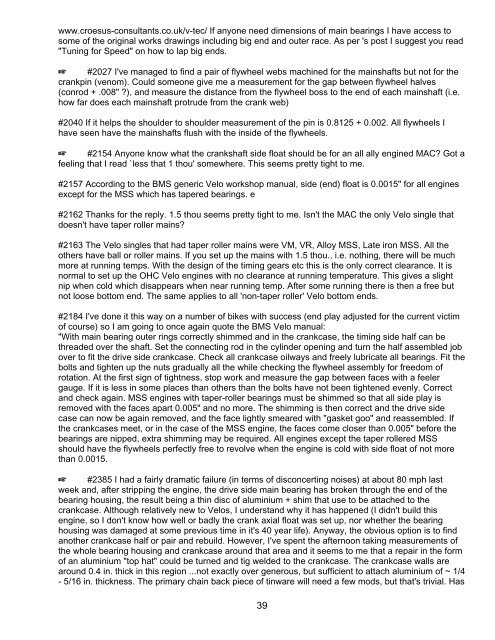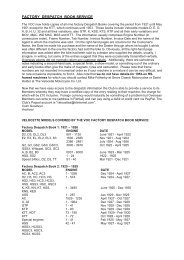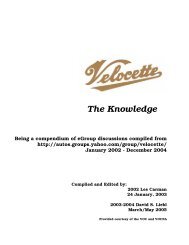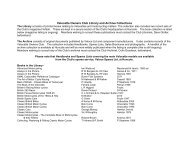The Knowledge - Velocette Owners Club
The Knowledge - Velocette Owners Club
The Knowledge - Velocette Owners Club
Create successful ePaper yourself
Turn your PDF publications into a flip-book with our unique Google optimized e-Paper software.
www.croesus-consultants.co.uk/v-tec/ If anyone need dimensions of main bearings I have access to<br />
some of the original works drawings including big end and outer race. As per 's post I suggest you read<br />
"Tuning for Speed" on how to lap big ends.<br />
L #2027 I've managed to find a pair of flywheel webs machined for the mainshafts but not for the<br />
crankpin (venom). Could someone give me a measurement for the gap between flywheel halves<br />
(conrod + .008" ?), and measure the distance from the flywheel boss to the end of each mainshaft (i.e.<br />
how far does each mainshaft protrude from the crank web)<br />
#2040 If it helps the shoulder to shoulder measurement of the pin is 0.8125 + 0.002. All flywheels I<br />
have seen have the mainshafts flush with the inside of the flywheels.<br />
L #2154 Anyone know what the crankshaft side float should be for an all ally engined MAC? Got a<br />
feeling that I read `less that 1 thou' somewhere. This seems pretty tight to me.<br />
#2157 According to the BMS generic Velo workshop manual, side (end) float is 0.0015" for all engines<br />
except for the MSS which has tapered bearings. e<br />
#2162 Thanks for the reply. 1.5 thou seems pretty tight to me. Isn't the MAC the only Velo single that<br />
doesn't have taper roller mains?<br />
#2163 <strong>The</strong> Velo singles that had taper roller mains were VM, VR, Alloy MSS, Late iron MSS. All the<br />
others have ball or roller mains. If you set up the mains with 1.5 thou., i.e. nothing, there will be much<br />
more at running temps. With the design of the timing gears etc this is the only correct clearance. It is<br />
normal to set up the OHC Velo engines with no clearance at running temperature. This gives a slight<br />
nip when cold which disappears when near running temp. After some running there is then a free but<br />
not loose bottom end. <strong>The</strong> same applies to all 'non-taper roller' Velo bottom ends.<br />
#2184 I've done it this way on a number of bikes with success (end play adjusted for the current victim<br />
of course) so I am going to once again quote the BMS Velo manual:<br />
"With main bearing outer rings correctly shimmed and in the crankcase, the timing side half can be<br />
threaded over the shaft. Set the connecting rod in the cylinder opening and turn the half assembled job<br />
over to fit the drive side crankcase. Check all crankcase oilways and freely lubricate all bearings. Fit the<br />
bolts and tighten up the nuts gradually all the while checking the flywheel assembly for freedom of<br />
rotation. At the first sign of tightness, stop work and measure the gap between faces with a feeler<br />
gauge. If it is less in some places than others than the bolts have not been tightened evenly. Correct<br />
and check again. MSS engines with taper-roller bearings must be shimmed so that all side play is<br />
removed with the faces apart 0.005" and no more. <strong>The</strong> shimming is then correct and the drive side<br />
case can now be again removed, and the face lightly smeared with "gasket goo" and reassembled. If<br />
the crankcases meet, or in the case of the MSS engine, the faces come closer than 0.005" before the<br />
bearings are nipped, extra shimming may be required. All engines except the taper rollered MSS<br />
should have the flywheels perfectly free to revolve when the engine is cold with side float of not more<br />
than 0.0015.<br />
L #2385 I had a fairly dramatic failure (in terms of disconcerting noises) at about 80 mph last<br />
week and, after stripping the engine, the drive side main bearing has broken through the end of the<br />
bearing housing, the result being a thin disc of aluminium + shim that use to be attached to the<br />
crankcase. Although relatively new to Velos, I understand why it has happened (I didn't build this<br />
engine, so I don't know how well or badly the crank axial float was set up, nor whether the bearing<br />
housing was damaged at some previous time in it's 40 year life). Anyway, the obvious option is to find<br />
another crankcase half or pair and rebuild. However, I've spent the afternoon taking measurements of<br />
the whole bearing housing and crankcase around that area and it seems to me that a repair in the form<br />
of an aluminium "top hat" could be turned and tig welded to the crankcase. <strong>The</strong> crankcase walls are<br />
around 0.4 in. thick in this region ...not exactly over generous, but sufficient to attach aluminium of ~ 1/4<br />
- 5/16 in. thickness. <strong>The</strong> primary chain back piece of tinware will need a few mods, but that's trivial. Has<br />
39





